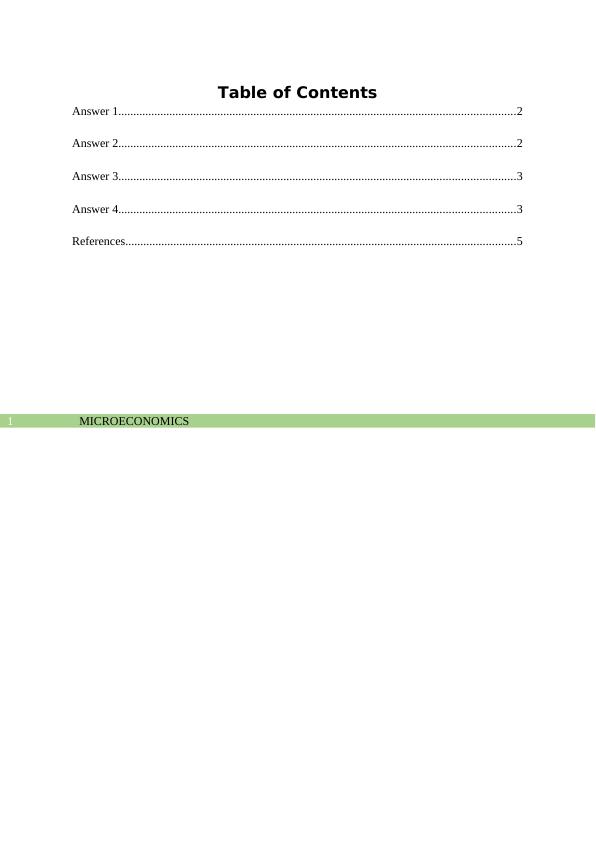Microeconomics - Monopoly and Perfect Competition
Added on 2022-10-10
6 Pages1080 Words283 Views
Running head: MICROECONOMICS
Microeconomics
Name of the Student
Name of the University
Student ID
Microeconomics
Name of the Student
Name of the University
Student ID

MICROECONOMICS1
Table of Contents
Answer 1....................................................................................................................................2
Answer 2....................................................................................................................................2
Answer 3....................................................................................................................................3
Answer 4....................................................................................................................................3
References..................................................................................................................................5
Table of Contents
Answer 1....................................................................................................................................2
Answer 2....................................................................................................................................2
Answer 3....................................................................................................................................3
Answer 4....................................................................................................................................3
References..................................................................................................................................5

MICROECONOMICS2
Answer 1
Monopolies and perfectly competitive firms both maximize where MR=MC because
marginal cost gives the amount of cost a firm would incur by producing one more unit and
marginal revenue gives the amount of revenue the firm would earn by selling one more unit
of product. Thus, if MR>MC, could earn more by producing and if MR<MC a firm would
makes losses by producing (Varian, 2014). Therefore, profit is maximized for both monopoly
and perfectly competitive firm at MR=MC. However, even if the profit maximizing condition
is same for both type of firm, price charged by monopoly firm is higher than price charged by
perfectly competitive firm because in perfect competition MR curve is horizontal as there are
infinite number of firms in perfect competition (Azevedo & Gottlieb, 2017). Hence, if
perfectly competitive firm charges price above MC then MR becomes zero as other firm
would charge a lower price as takes entire demand. Thus, in perfect competition price equals
MC. On the other hand, in monopoly MR is downward sloping and lies below demand curve
as it is steeper than the demand curve, thus charging a higher price would only decrease the
quantity demanded. Thus, the monopoly firm produces at MR=MC but charges the price
given by the demand curve which is higher than MC. Thus, price in monopoly is higher than
MC.
Answer 2
Monopolies and perfectly competitive firms would make losses even after operating
at MR=MC, when the when price of the product is below average total cost. However, both
the firms would continue to produce even after making losses if certain conditions are met.
Suppose, the firms are producing below average total cost but above average variable cost,
then the firms might continue to operate, as it would cover entire variable cost and some part
of the fixed cost (Balakrishnan, Labro & Soderstrom, 2014). The firm would also continue to
Answer 1
Monopolies and perfectly competitive firms both maximize where MR=MC because
marginal cost gives the amount of cost a firm would incur by producing one more unit and
marginal revenue gives the amount of revenue the firm would earn by selling one more unit
of product. Thus, if MR>MC, could earn more by producing and if MR<MC a firm would
makes losses by producing (Varian, 2014). Therefore, profit is maximized for both monopoly
and perfectly competitive firm at MR=MC. However, even if the profit maximizing condition
is same for both type of firm, price charged by monopoly firm is higher than price charged by
perfectly competitive firm because in perfect competition MR curve is horizontal as there are
infinite number of firms in perfect competition (Azevedo & Gottlieb, 2017). Hence, if
perfectly competitive firm charges price above MC then MR becomes zero as other firm
would charge a lower price as takes entire demand. Thus, in perfect competition price equals
MC. On the other hand, in monopoly MR is downward sloping and lies below demand curve
as it is steeper than the demand curve, thus charging a higher price would only decrease the
quantity demanded. Thus, the monopoly firm produces at MR=MC but charges the price
given by the demand curve which is higher than MC. Thus, price in monopoly is higher than
MC.
Answer 2
Monopolies and perfectly competitive firms would make losses even after operating
at MR=MC, when the when price of the product is below average total cost. However, both
the firms would continue to produce even after making losses if certain conditions are met.
Suppose, the firms are producing below average total cost but above average variable cost,
then the firms might continue to operate, as it would cover entire variable cost and some part
of the fixed cost (Balakrishnan, Labro & Soderstrom, 2014). The firm would also continue to

End of preview
Want to access all the pages? Upload your documents or become a member.
Related Documents
Market Structure And Demandslg...
|8
|847
|15
Economic Questions Answers 2022lg...
|22
|4323
|64
Microeconomics 101: Economics Essaylg...
|11
|2800
|195
Microeconomics Questions and Answers 2022lg...
|12
|1803
|41
Market Structure and its Types - Deskliblg...
|7
|942
|88
Principles of Economicslg...
|13
|2367
|221